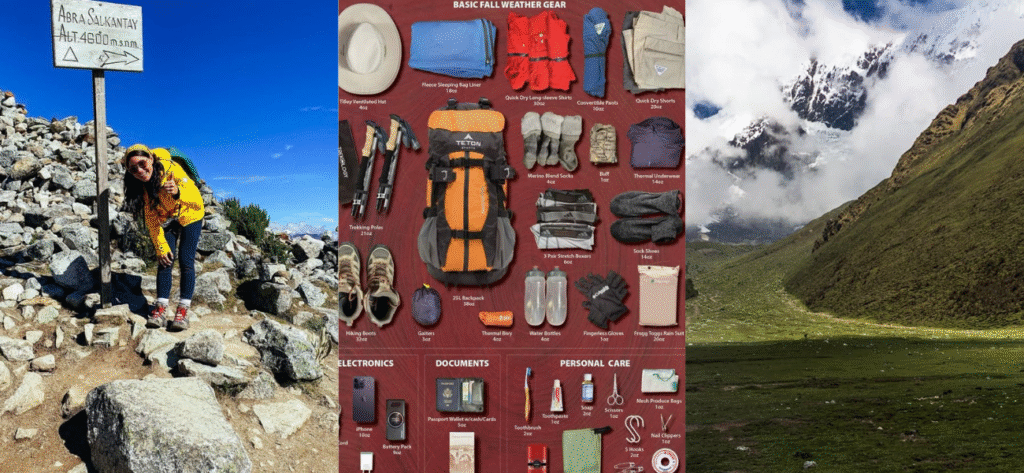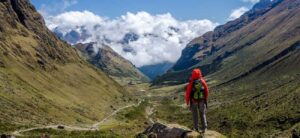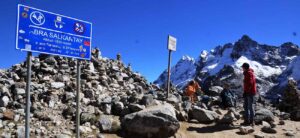What to Bring on the Salkantay Trek
When I first started preparing for the Salkantay Trek to Machu Picchu, I wasn’t sure what I truly needed to pack. I read tons of blogs, watched videos, and still had doubts. Now, after completing the trek myself, I want to share exactly what I packed (and what I wish I had packed) to help you get ready for this amazing adventure.
Essentials I Brought (And Was Glad I Did):
- Good Hiking Boots:
Absolutely essential. I wore boots that I had already broken in, and they saved my feet on the rocky and uneven trails. - Layered Clothing:
Mornings were cold, afternoons were warm, and nights were freezing at high altitude camps like Soraypampa. I packed thermal shirts, a fleece jacket, and a waterproof outer shell, plus quick-dry T-shirts and hiking pants. - Rain Jacket and Rain Cover for Backpack:
Even during the dry season, short rains can happen, especially near the cloud forest area. My lightweight rain jacket was a lifesaver. - Sleeping Bag (Four-Season):
Nights got really cold, especially at high-altitude camps. I brought a four-season sleeping bag rated for low temperatures, and it made a huge difference. - Daypack:
I carried a small, comfortable daypack with essentials like water, snacks, sunscreen, and a camera. - Headlamp:
Very useful for early mornings and late-night bathroom trips in the campsites. - Water Bottle or Hydration System:
I brought a 2L hydration bladder, which made it easy to sip water during the trek. - Snacks:
Although meals were provided, having extra energy bars, nuts, and chocolate really helped on long hiking days. - Sunscreen and Lip Balm with SPF:
The sun at high altitudes is intense, even if it’s cloudy. - Toiletries:
I packed biodegradable soap, a toothbrush, toothpaste, wet wipes, hand sanitizer, and a quick-dry towel. - First Aid Kit:
I included blister patches, ibuprofen, altitude sickness pills (just in case), and personal medication. - Cash in Small Bills:
For small purchases like snacks, tips, and souvenirs along the way.
Things I Wish I Had Brought:
- Walking Poles:
I didn’t bring any, thinking I wouldn’t need them, but I ended up renting a pair. They were really helpful, especially during the steep downhill sections. - Extra Pair of Shoes or Sandals:
After hiking all day, it would have been amazing to have something comfortable to wear around the camps. - More Socks:
You can never have too many clean, dry socks!
Bonus Items That Made My Trek Even Better:
- Buff or Scarf:
Perfect for protecting against dust and the cold wind. - Portable Charger:
There’s very limited electricity during the trek, so my power bank was essential to keep my phone and camera charged. - Travel Pillow:
It made sleeping in tents way more comfortable.
Final Thoughts
Packing smart was a big part of why I enjoyed the Salkantay Trek so much. The weather can change quickly, and being prepared makes the difference between an amazing adventure and an uncomfortable struggle.
If you’re about to do the trek, focus on lightweight but essential gear — and don’t forget to break in your boots before you go!
Happy trekking! 🏔️✨
What you should do before booking Salkantay Trek to Machu Picchu
1. What is the Salkantay Trek, and how does it compare to the Inca Trail?
The Salkantay Trek is an alternative route to Machu Picchu, offering breathtaking landscapes, including snow-capped mountains, cloud forests, and high-altitude passes. Unlike the Inca Trail, the Salkantay Trek does not require a permit and is less crowded, providing a more adventurous experience.
2. How many days does the Salkantay Trek take to reach Machu Picchu?
The standard Salkantay Trek takes 5 days and 4 nights, covering approximately 72 km (45 miles). However, there are shorter and longer variations of the trek available.
3. What is the difficulty level of the Salkantay Trek?
The Salkantay Trek is considered moderate to challenging, as it involves hiking at high altitudes and steep ascents. The highest point is the Salkantay Pass at 4,650 m (15,255 ft). Proper acclimatization is recommended before starting the trek.
4. Do I need a permit to hike the Salkantay Trek?
No, unlike the Inca Trail, the Salkantay Trek does not require a special permit. However, you do need an entrance ticket for Machu Picchu, which should be booked in advance.
5. What is the best time of year to hike the Salkantay Trek?
The best time to hike the Salkantay Trek is during the dry season (April to October). The weather is more stable, with clear skies and less rain. The rainy season (November to March) can make the trail muddy and challenging.
6. What should I pack for the Salkantay Trek?
Essential items include:
- Hiking boots (waterproof and comfortable)
- Warm layers (temperatures drop at night)
- Rain jacket or poncho
- Sleeping bag (suitable for cold weather)
- Sun protection (hat, sunglasses, sunscreen)
- Water bottle and purification tablets
- Basic first aid kit
7. Is altitude sickness a concern on the Salkantay Trek?
Yes, altitude sickness can be an issue, especially at the Salkantay Pass (4,650 m). It is recommended to spend a few days in Cusco (3,400 m) before the trek to acclimatize. Staying hydrated, avoiding alcohol, and chewing coca leaves can help with symptoms.
8. How do I get to Machu Picchu from the end of the Salkantay Trek?
After reaching Hidroelectrica, you have two options:
- Hike 3 hours to Aguas Calientes.
- Take a 30-minute train from Hidroelectrica to Aguas Calientes.
From Aguas Calientes, you can hike or take a bus up to Machu Picchu.
9. Are there accommodation options along the Salkantay Trek?
Yes, most trekking companies provide campsites or eco-lodges along the route. Some upgraded tours offer more comfortable accommodations, such as glass cabins or domes. The final night is usually spent in a hotel in Aguas Calientes.
10. Can I visit Machu Picchu without hiking the Salkantay Trek?
Yes, you can take a train from Cusco to Aguas Calientes, followed by a short bus ride or hike up to Machu Picchu. This is the most popular option for visitors who prefer not to hike.
You must be interested
- Salkantay Trek to Machu Picchu
- Salkantay Trail 5 days 4 nights
- Salkantay Trek difficulty level
- Salkantay vs Inca Trail comparison
- Best time to hike Salkantay Peru
- Salkantay Trek tour price 2026
- Guided Salkantay Trek packages
- Salkantay Trek altitude and acclimatization
- Salkantay Trekking tours from Cusco
- Salkantay Trek full itinerary
Salkantay Travel Information
- Salkantay Trek Food: What You’ll Eat on the Trail
- Birds of the Salkantay Trek: Species You Can Spot on the Route
- Is the Salkantay Trek Dangerous?
- Salkantay Trek Altitude: Heights Along the Route
- Flora and Fauna in Salkantay Trek
- Altitude Sickness on the Salkantay Trek
- Salkantay Trek Difficulty: How Hard Is the Route?
- Salkantay Trek FAQs: Answers to Common Questions
- Best Time to do Salkantay trek
- Training for Salkantay Trek: How to Get Ready
- How long is the Salkantay Trek?
- Salkantay Trek Price: How Much Does It Cost?
- What Is the Salkantay Trek?
- What to Bring on the Salkantay Trek?
- Best Time to Do Salkantay Trek
- Your Insider’s Guide to Salkantay Trek
- Where is Salkantay?
- Salkantay highlights
- Tour Montaña de Colores con Transporte














